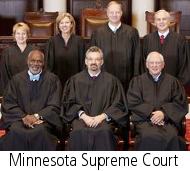5/4/2009
Minnesota Supreme Court Orders Access to Breathalyzer Source CodeMinnesota prosecutors will have to produce the source code for breathalyzers following a ruling by the state supreme court.

The Minnesota Supreme Court on Thursday upheld a lower court's decision to require production of the source code used by breath testing machines. This code is responsible for calculating the estimate of blood alcohol content which frequently is the only relevant piece of evidence in drunk driving (DUI) cases. When Dale Lee Underdahl and Timothy Arlen Brunner were both charged with DUI in separate cases in 2006 and 2007, they sought access to the source code for the Intoxilyzer 5000EN.
State officials resisted the defendants' requests, claiming the software controlling the device was not relevant and, in any case, it was private information under the sole control of the machine's manufacturer, CMI Inc. CMI claimed the information was a "trade secret" and refused a district court order to produce the code. This led to the prospect that the charges against Underdahl and Brunner would be dismissed for lack of evidence, so before this could happen, the state asked the court of appeals to strike down both discovery requests. The appeals court agreed with the state.
The supreme court found fault with the reasoning of the appeals court and split the difference. It upheld Brunner's request for the code and turned down Underdahl's. In a partial dissent, Justices Alan C. Page and Paul Anderson explained the source code's importance while arguing that Underdahl's case was identical to Brunner's.
"In this case, guilt or innocence depends on Underdahl's blood alcohol content," the dissent stated. "His blood alcohol content is assessed by the Intoxilyzer 5000EN. The source code of the Intoxilyzer 5000EN is the programming instruction used by the machine to assess blood alcohol content. The operation of the source code determines the reliability of the Intoxilyzer 5000EN's blood alcohol content readings. The reliability of the Intoxilyzer 5000EN is a question that the jury will have to decide before determining Underdahl's guilt or innocence. Thus, I conclude that the source code relates to Underdahl's guilt or innocence and that, under Rule 9.01, subd. 2(3), its disclosure is required."
The majority, however, turned down Underdahl's request simply because he failed to make a sufficient argument in the court's eyes to establish the relevance of the breath testing machine's underlying software. To require disclosure, the court ruled that the defense must make an argument to establish relevance. Because Brunner submitted nine exhibits to bolster his claim, the high court ruled that the district court court judge had the discretion to mandate its disclosure. Both of the DUI court cases can now move forward.
Other states have addressed the issue of the reliability of breath testing machines. In 2005, a lower court in Florida ordered the production of breathalyzer source code. Last year, the New Jersey Supreme Court reinstated breathalyzer use even though an examination of the source code revealed shoddy programming practices.
A copy of the case is available in a 150k PDF file at the source link below.


